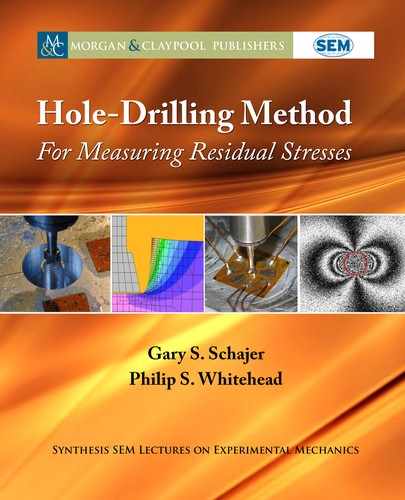108 5. STRESS COMPUTATIONS
drilled deeper by a small increment depends only on the stresses within that increment. us,
the stresses within each increment can be determined by comparing the strain differences from
one increment to the next with those from the calibration test. is approach ignores the ge-
ometric effect described in Section 5.6, and so produces only an approximate result. In terms
of the Integral Method, the
N
a and
N
b matrices would have constant values down each column,
arranged such that the sums of the rows are the same as those from the Integral Method. Be-
cause of its mathematical simplicity, the Differential Strain Method is still occasionally used for
hole-drilling and ring-core calculations. However, because of the approximation involved, the
results must be handled with caution.
In the Average Stress Method, it is assumed that the stresses at all depths contribute
equally to the surface strain response. us, the stresses within a hole depth increment can
be determined by finding the value that gives the same average as observed in the calibration
test. is approach ignores the Stress Effect described in Section 5.6, so also produces only an
approximate result. In terms of the Integral Method, the
N
a and
N
b matrices would be uniform
within each row, arranged such that the sums of the rows are the same as those from the Integral
Method. e degree of approximation of the Average Stress Method is greater than for the
Differential Strain Method, and it is now rarely used.
5.8.2 POWER SERIES METHOD
e Power Series Method was introduced as an alternative to the Integral Method. Instead
of representing the through-depth distribution of stresses in terms of the stress values within
the various hole depth increments, it describes the stresses in terms of a power series based on
depth from surface, h, i.e., 1, h, h
2
: : :, etc. While this approach is mathematically satisfactory,
in practice, evaluations of the higher order terms tend to become unstable because of St. Venant
effects. Consequently, only the lower terms can be determined reliably, typically just the first
two terms: constant and linear. Because of this, the Power Series Method is suitable only for
smoothly varying residual stress profiles. Going back one step further to the case of uniform
stresses, the Power Series Method can be applied using just one term. In that case, it provides
the Equivalent Uniform Stresses specified in Equations (5.12).
5.8.3 SPECIMEN THICKNESS
e ASTM Standard Test Method E837-13 recognizes two extreme measurement regimes: the
“thick” case where the specimen thickness is greater than 1.0 times the strain gauge rosette mean
diameter, and the “thin” case where the specimen thickness is less than 0.2 times the strain gauge
rosette mean diameter. ese numbers are for Type A and B rosettes; the corresponding factors
for a Type C rosette are 1.2 and 0.24. e graphs of calibration constants in Figure 5.4 refer to
the “thick” case. Most hole-drilling residual stress measurements are of the “thick” type.
e “thin” case occurs in measurements on sheet or plate type specimens, for which the
hole goes all the way through the material. Historically, this configuration is important because
..................Content has been hidden....................
You can't read the all page of ebook, please click here login for view all page.
